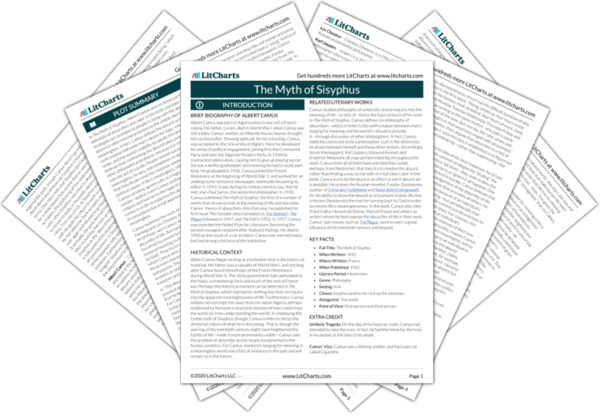Absurdism and Meaning
Absurdism is often mischaracterized as solely the idea that life is inherently meaningless—and while that is undoubtedly an important aspect of absurdism, it isn’t the whole story. Camus specifically defines absurdism as the confrontation between two key elements: on the one hand, there is humankind’s “wild longing for clarity,” meaning, and “order.” On the other hand, people find nothing in the world that gives evidence of answering this search for meaning—life’s biggest questions are answered…
read analysis of Absurdism and MeaningHumankind and the Natural World
The Myth of Sisyphus poses a dilemma that goes to the heart of what it means to be alive. While people strive to create good lives for themselves, the inevitability of death renders this effort—according to Camus—ultimately meaningless. This tension between the human desire for logic and meaning and the world’s refusal to conform to that desire is the central idea of the book, a concept Camus deems “absurdism.” As a key part of…
read analysis of Humankind and the Natural WorldMasculinity
Once he has established his definition of the absurd, Camus seeks to provide the reader with examples—which he says, categorically, are not models—of the “absurd man.” That is, he offers up figures who, in his opinion, take on the absurd and incorporate it into their lives, particularly with the aim of seeking out “more” (as opposed to “better”) experiences. But in this chapter, as with the rest of the book, there’s a notable absence of…
read analysis of Masculinity
Philosophy and Art
Camus implores his readers not to try to eliminate the absurd, but rather to bring it into daily life as an ever-present reality. Philosophy, the book argues, has so far been incapable of doing so because, though capable of diagnosing the absurd, its practitioners have relied on illogical leaps of faith to try to “solve” it. Art, on the other hand, plays a more tangibly useful role because it can help provide examples of the…
read analysis of Philosophy and Art






